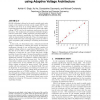Free Online Productivity Tools
i2Speak
i2Symbol
i2OCR
iTex2Img
iWeb2Print
iWeb2Shot
i2Type
iPdf2Split
iPdf2Merge
i2Bopomofo
i2Arabic
i2Style
i2Image
i2PDF
iLatex2Rtf
Sci2ools
ICCAD
2009
IEEE
2009
IEEE
Mitigation of intra-array SRAM variability using adaptive voltage architecture
SRAM cell design is driven by the need to satisfy static noise margin, write margin and read current margin (RCM) over all cells in the array in an energy-efficient manner. These constraints determine both the minimum cell size and supply voltage. RCM is set by the maximum read access time over the array. The randomness of transistor threshold voltages, and thus read times, makes maximum read time follow extreme order statistics, specifically, the Gumbel distribution which is characterized by long tails. Thus, the margin specification needs to be met at the high sigma corners in order to reach acceptable yield, resulting in oversizing and increased VDD. In this work, we demonstrate that a reduced-area bitcell design is achievable by reducing the impact of intra-array randomness through a new architecture that employs an adaptive voltage scheme in a partitioned SRAM array. The key idea is to be able to shift empirical distributions (realizations) of read time in a set of rows that form...
Access Time | Adaptive Voltage | Hardware | ICCAD 2009 | Voltage |
| Added | 18 Feb 2011 |
| Updated | 18 Feb 2011 |
| Type | Journal |
| Year | 2009 |
| Where | ICCAD |
| Authors | Ashish Kumar Singh, Ku He, Constantine Caramanis, Michael Orshansky |
Comments (0)

